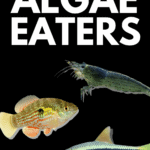For many aquarists, algae eaters are seen as practical tank inhabitants that kill two birds with one stone. Not only do they lend a ton of character to their respective homes, they also play a major role in keeping it clean. By munching on the excess algae in your tank, algae eaters create a cleaner and more aesthetically appealing habitat for their tankmates.
This article focuses on some of our top algae eater picks for a clean and healthy aquarium. We’ve included fish with different temperaments and algae preferences, so you’re bound to find one (or several) that’s right for you!
Types of Algae
Algae are a common problem in aquariums and vary in appearance, size and species. Here are some of the most common types of algae in aquariums.
Black Beard Algae (Audouinella/Black Brush Algae/BBA)
We’re kicking this list off with a type of algae that’s notoriously difficult to remove. Black beard algae typically grow in poorly maintained tanks – these tanks have a ton of organic waste buildup, thus creating an environment that allows black beard algae to thrive.
True to their name, this type of algae resembles… well, a black beard. Fuzzy black beard. The short, wispy tendrils of this algae flourish on almost every surface, which is great news for the algae, but not so good for fishkeepers who want a gorgeous-looking tank.
Green Spot Algae (GSA/Coleochaete Orbicularis)
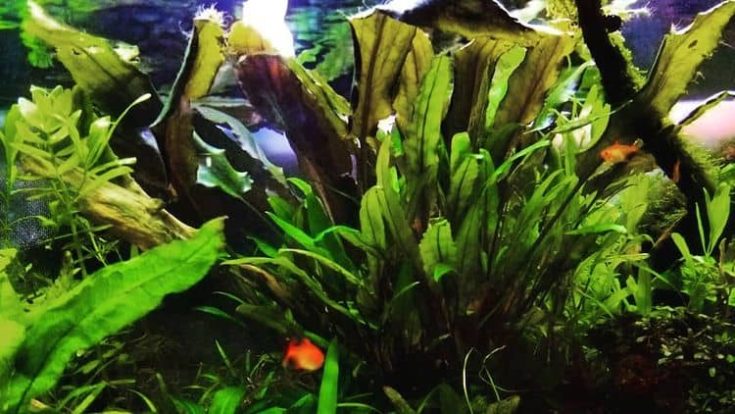
Again, this one has a descriptive name. Green spot algae look exactly the way you’d expect. This type of algae gravitates toward hard surfaces, particularly tank walls. And once it’s found its new home, it gradually grows outwards, expanding the radius of the splotch it’s formed.
Generally, green spot algae form when the tank receives too much of a good thing. Too much light, too many nutrients… these are all factors that can lead to the dreaded green spot forming on your tank walls. Be sure to practice moderation in all things – especially when it comes to lighting and fertilization!
Blanket Weed (Cladophora sp.)
Warm, fuzzy blankets may sound amazing on a cold winter night, but the last thing you want is a blanket of algae draped over your tank. And that’s exactly what blanket weed is. This “weed” is actually a type of algae that generally grows over ponds.
As for its cause? Like most algae species, blanket weed appears wherever there’s too much sunlight and nutrients. High pH can also be a contributing factor.
Blue-Green Algae
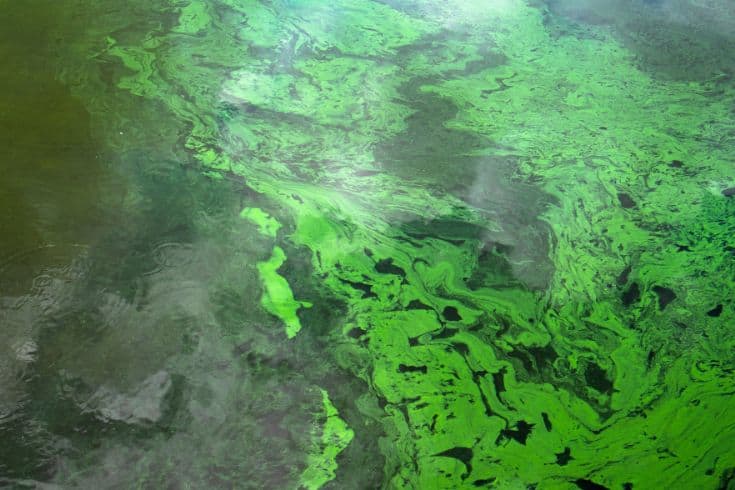
Blue-green algae aren’t super common, but when they definitely make their presence felt when they do appear. This type of algae is known for causing algae blooms, a phenomenon in which algae causes an entire body of water to change colors entirely.
Hair/Thread Algae
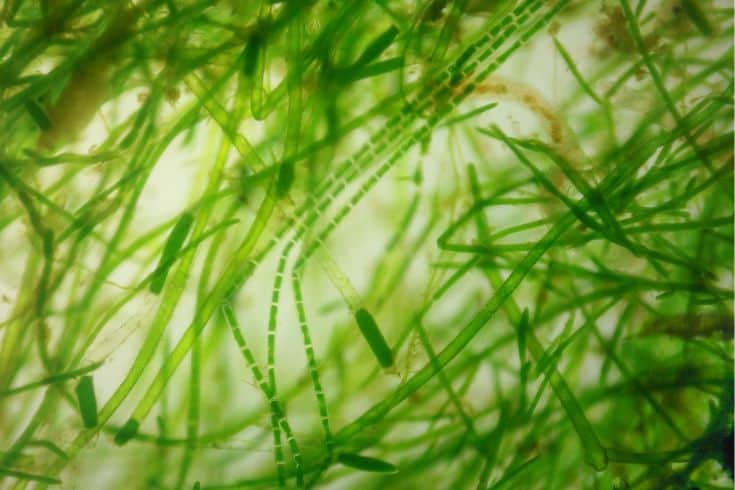
There are many different factors that can cause hair algae to appear, but a CO2 imbalance is often the primary cause. If you’ve noticed these long, thin strands of algae in your tank, it may be a sign that you need to increase carbon dioxide levels in your tank!
Brown Algae (Diatoms)
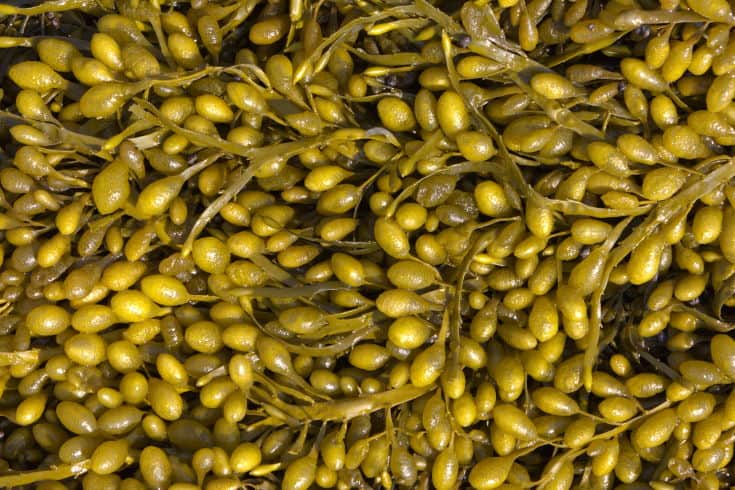
Diatoms form a thin brown layer over the different surfaces in a tank, making them quite a nuisance. They typically occur in tanks that have high silicate levels, so be sure to check your water supply to make sure this isn’t the case. Sometimes, they may also occur as part of the tank cycling process – this is completely normal, and all you need to do is wait it out!
Rhizoclonium Algae
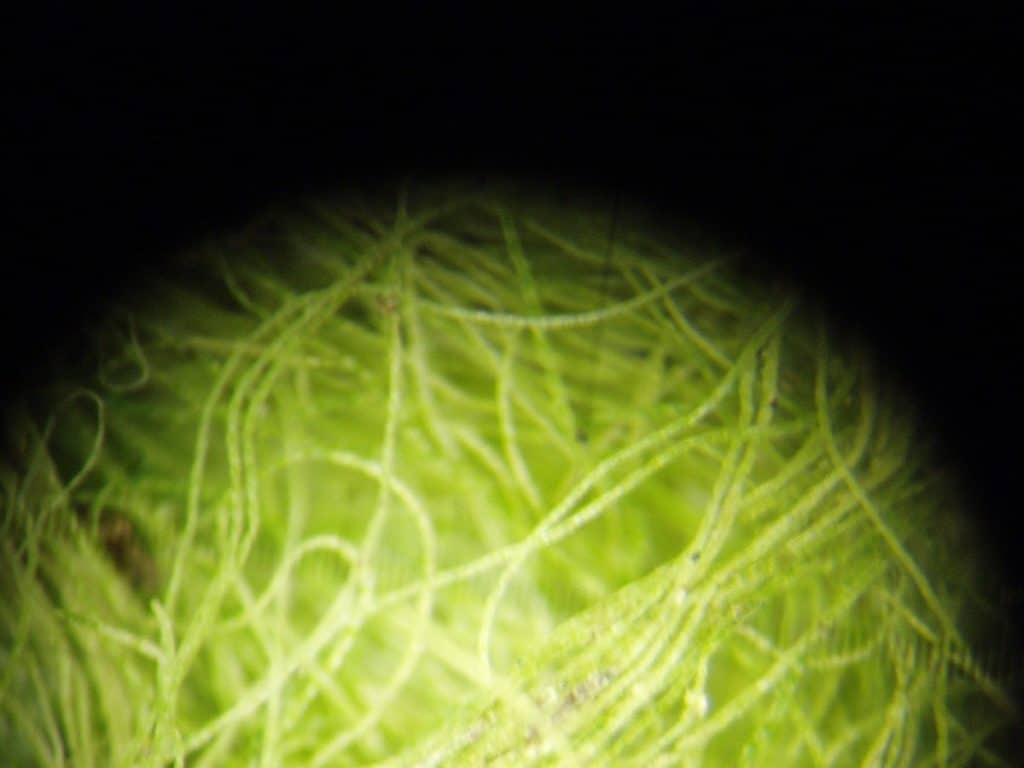
Rhizoclonium algae may remind you of hair algae, with one notable difference. These guys have a distinct green hue, as they’re part of the green algae family!
Green Dust Algae (GDA)
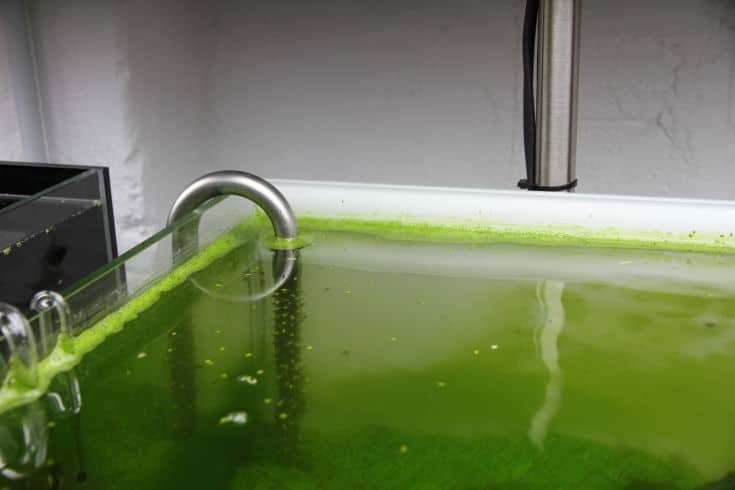
Much like diatoms, green dust algae will form a stubborn layer of algae over every surface in your tank. The only difference is that these guys are green, while diatoms are brown.
Spirogyra
Placed a spirogyra cell under a microscope, and you’ll quickly understand why these guys are named as such. Their chloroplasts (cells containing green pigment for photosynthesis) are arranged in a distinct spiral, making them rather gorgeous to look at! In your tank, though, these guys will look like a type of hair algae.
Oedogonium Algae
Sometimes known as green fuzz algae, Oedogonium algae often develops in tanks that lack sufficient carbon dioxide levels. You’re probably able to picture what these algae look like based on their name alone, but just in case – think of green hair algae, but with shorter strands. Green fuzz!
Staghorn Algae (Compsopogon sp.)
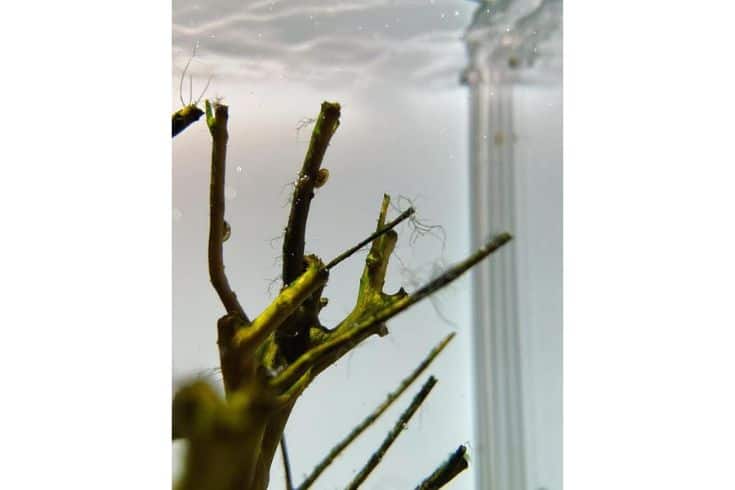
Picture a stag. Now, picture its horn. If you thought of a red, tubular structure, you’d be spot on! That’s exactly what staghorn algae look like. Its thin, red tendrils can often be found on plants and tank decor, making this a very distinctive algae type indeed.
Red Slime Algae
Last but not least, we have red slime algae. Well… technically, it’s not an algae, but a type of bacteria. Cyanobacteria is a type of photosynthetic bacteria that can be found in both freshwater and saltwater tanks. It appears in patches of red, which is how it got its name!
21 Best Algae Eaters for a Clean and Healthy Aquarium
Now that we know more about the different kinds of algae that can grow in a tank, we can look at some of the most popular and top-rated freshwater aquarium algae eaters.
1. Siamese Algae Eater
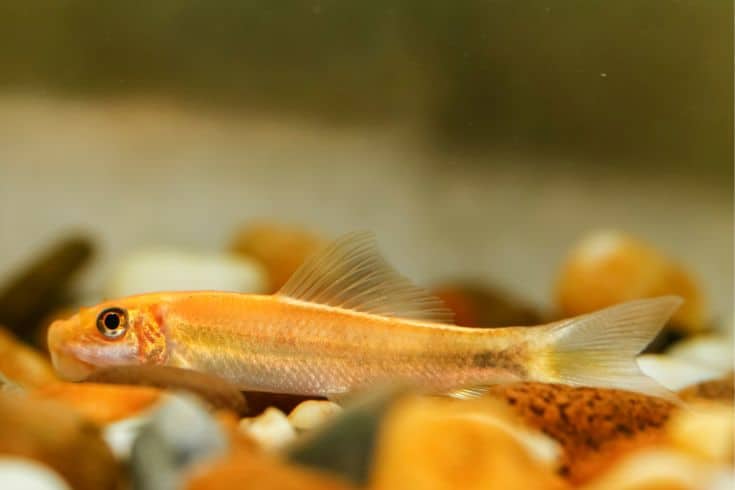
- Freshwater/Saltwater: Freshwater
- Tank size: 25 gallons
- Types of algae they eat: Hair algae, black beard algae, soft green and brown algae
The first entry on our list is a freshwater fish that’s established itself as a mainstay in freshwater tanks. Meet the Siamese Algae Eater! These guys are incredibly hardy and do a great job of eating all kinds of algae, including species such as hair algae, black beard algae, as well as soft green and brown algae. In fact, there’s not a whole lot these guys won’t eat when it comes to algae!
These fish are also very easy to care for and can even be kept in smaller aquariums. 25 gallons is a good minimum for these guys, and will give you enough space to keep a small school of them. Because Siamese Algae Eaters are so peaceful, they’re also great tankmates for timid, shy, and peaceful fish. Just be sure not to keep them with fish that are too large – you don’t want them to become lunch!
2. Chinese Algae Eater
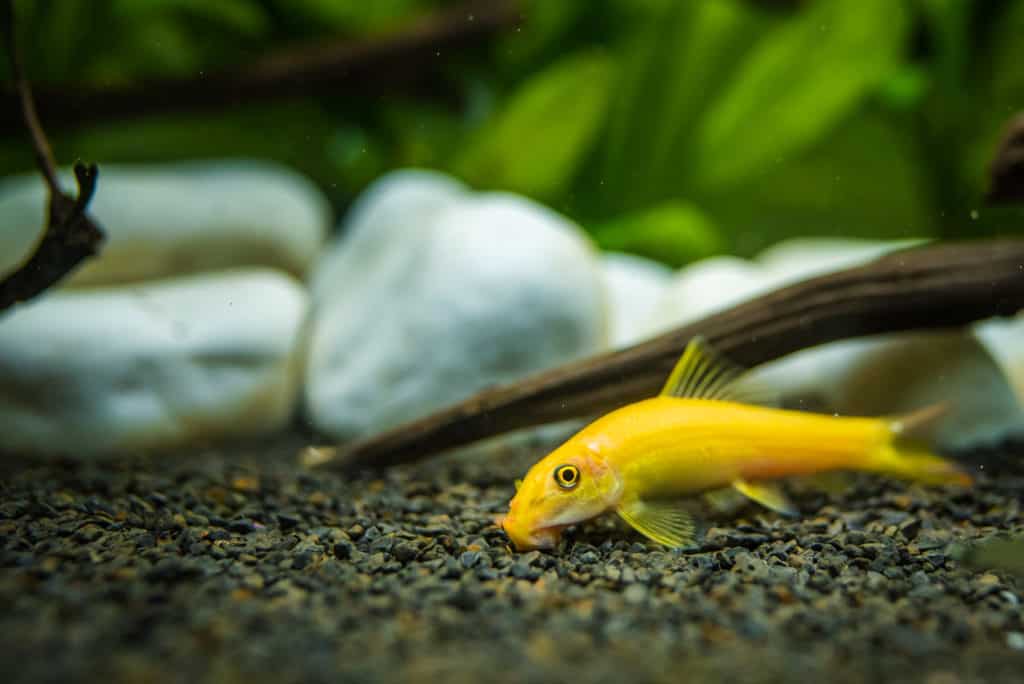
- Freshwater/Saltwater: Freshwater
- Tank size: 50 gallons
- Types of algae they eat: Soft green and brown algae
Think of the Chinese Algae Eater as the Siamese Algae Eater’s lesser-known cousin. Contrary to what their name implies, these fish actually hail from Northern India. In the wild, these fish can grow up to 11 inches in length, which makes them one of the bigger algae eaters around. However, their larger size also makes them a little more prone to aggression, so please stock your tank strategically!
Chinese Algae Eaters feed by attaching their sucker-like mouths to surfaces and then scraping off algae. Their feeding style makes them particularly well-suited for cleaning soft algae off plants, rocks, and other kinds of tank decor! If your tank doesn’t contain enough soft algae to keep these fish satisfied, be sure to supplement their diets with algae wafers or an appropriate type of commercial food.
3. Twig Catfish
- Freshwater/Saltwater: Freshwater
- Tank size: 35 gallons
- Types of algae they eat: Green algae, biofilm
Twig Catfish Next up is the Twig Catfish, which has a soft spot for green algae and biofilm. The former is one of the most common and annoying types of algae in aquariums, while the latter, being a mix of bacteria and decaying organic matter, is often overlooked but can still cause water quality issues if left unchecked. Twig catfish will happily snack on both, doing a great job of keeping things under control.
The Twig Catfish is also quite active and entertaining, making it a great addition to any aquarium. Its appearance, resembling a small twig, is quite unique and adds a great texture to any tank. Just remember that these fish are shy, so be sure to provide plenty of hiding spots and keep the tank well-planted. And do provide at least 35 gallons of space – despite being quite small, these are active fish that enjoy swimming!
4. Otocinclus Catfish
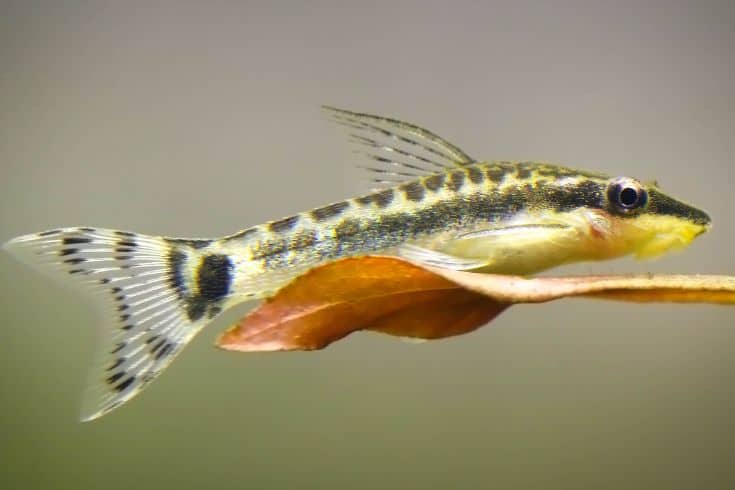
- Freshwater/Saltwater: Freshwater
- Tank size: 10 gallons
- Types of algae they eat: Green dust algae, diatoms/brown algae, and green algae
Do you have a freshwater tank that’s on the smaller side? Just because you’re limited by space doesn’t mean you have to sacrifice your algae-eating abilities! The Otocinclus Catfish is the perfect choice for smaller tanks, as these tiny fish have a maximum length of 2 inches. This means that you can comfortably house 3-4 of them in a 10-gallon tank, and have extra room to decorate your tank.
Because otocinclus catfish are so tiny, they are one of the few algae eaters that will clean up diatoms in your tank. These are a type of phytoplankton – tiny single-celled algae that are invisible to the naked eye. However, they can attach themselves to surfaces in your aquarium, and cause your tank to turn yellowish. Otocinclus catfish will happily munch away on these, helping to keep your tank looking crystal clear!
5. Whiptail Catfish
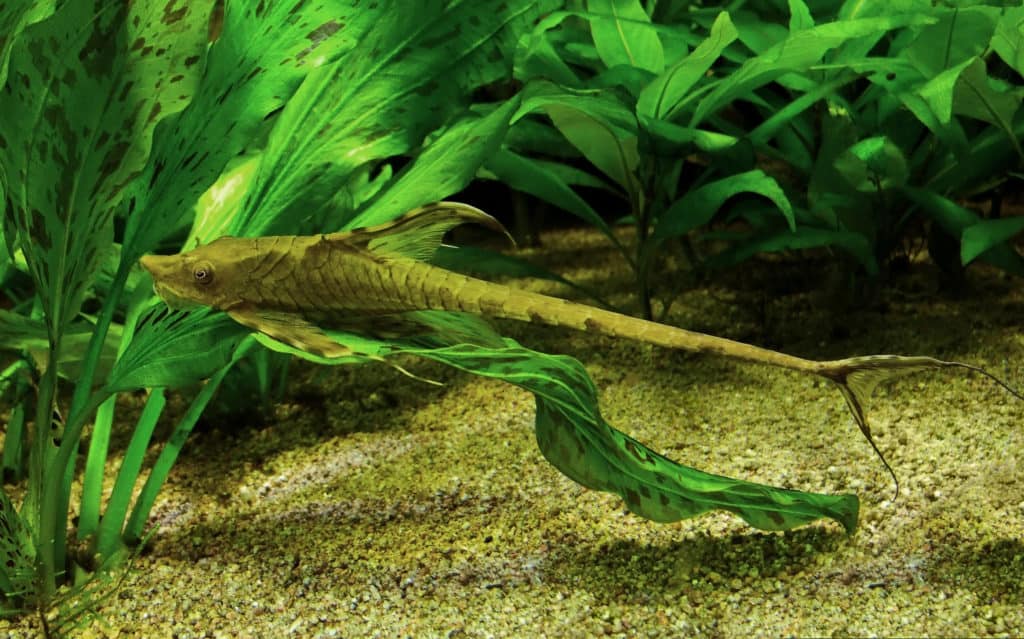
- Freshwater/Saltwater: Freshwater
- Tank size: 30 gallons
- Types of algae they eat: Green spot algae
Whiptail catfish are certainly one of the more unique-looking entries on our list. These fish have distinctive slender tails with tiny barbs, and they come in a variety of colors. Whether you’re looking for a brick red fish to complement your aquarium or a more subtle grey and black combo, you’re bound to find a whiptail catfish that suits your tank.
Of course, their appearance isn’t the only thing these fish have going for them. Whiptail catfish are also voracious algae eaters, happily munching away on all kinds of algae in your tank. They’re also relatively hardy and can thrive in a wide range of water conditions. The only downside is that they can be a bit territorial when defending their nest. However, we recommend using a breeding tank anyway!
6. Bristlenose Pleco
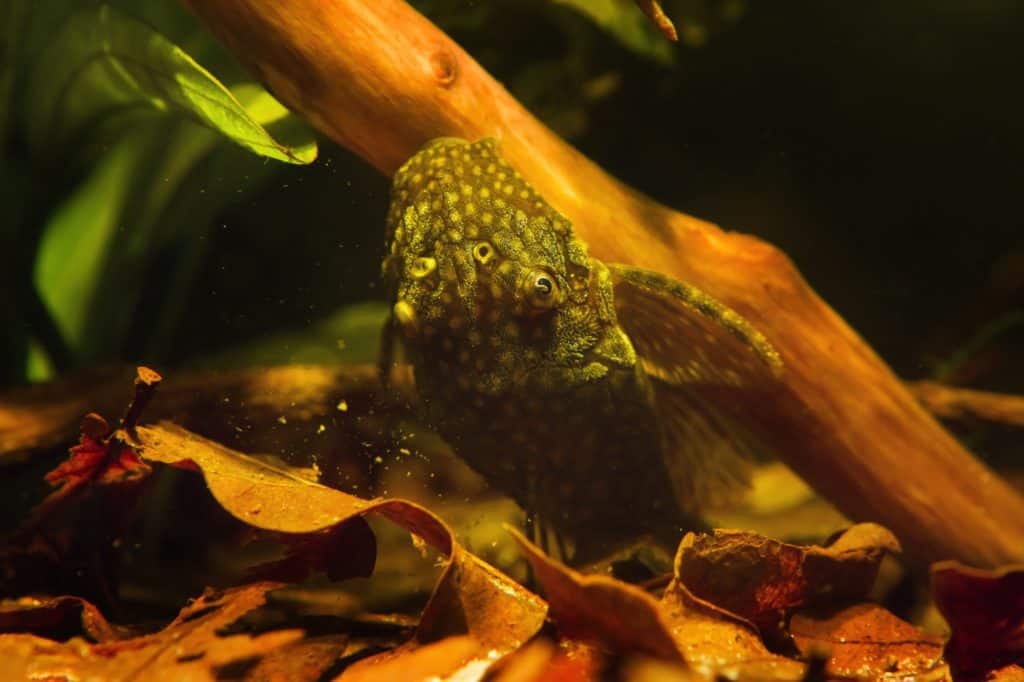
- Freshwater/Saltwater: Freshwater
- Tank size: 30 gallons
- Types of algae they eat: Green and brown algae
Bristlenose pleco owners will all attest to the fact that these are some of the most underrated algae eaters in the fishkeeping hobby. Despite being some of the most common plecos out, they remain a favorite among aquarists. These fish enjoy grazing on green and brown algae, leaving your tank looking good as new in no time.
In addition to their reliability as algae eaters, these are also peaceful species that will get along with most fish in a community tank. They are also not too demanding as far as tank size requirements go, and can even be kept in tanks as small as 30 gallons. Keep in mind that they are accustomed to fast-flowing, well-oxygenated waters, so please invest in a filter and pump that will meet their needs!
7. Garra (Doctor Fish)
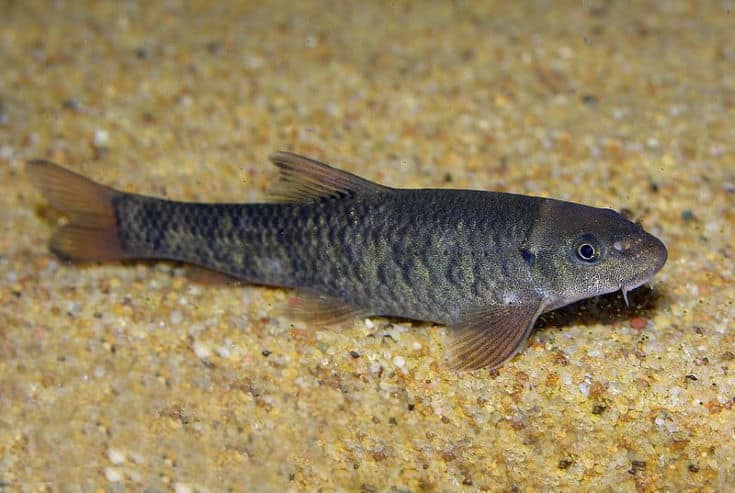
- Freshwater/Saltwater: Freshwater
- Tank size: 30 gallons
- Types of algae they eat: Brown algae, green algae, biofilm, black beard algae
We get it – this is a strange name. But those in the know might recognize these “doctor fish” as the little guys inhabiting tanks in foot spas. For the uninitiated, Garra are small, omnivorous grey fish that munch on practically everything. They’re often used to munch on dead skin cells in spas, but if you happen to get your hands on these guys, they’ll also do an excellent job of keeping your tank algae-free!
What type of algae does these fish eat? Well, if they’re happy to munch on calluses, you can bet they’ll be more than happy to chow down on most types of algae. Soft algae? Of course. Biofilm? Sure. Black beard algae? No problem! These fish will happily eat almost any type of algae, though they may also neglect your algae in favor of other food sources such as frozen and live food.
8. Mollies
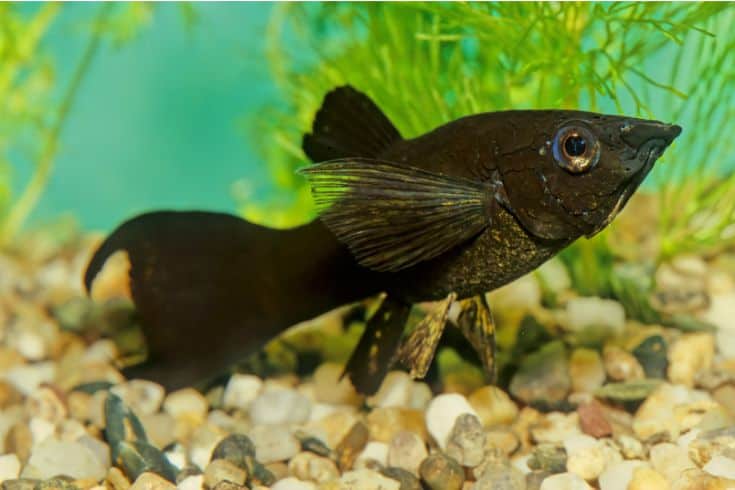
- Freshwater/Saltwater: Freshwater and saltwater
- Tank size: 20 gallons
- Types of algae they eat: Hair algae
As far as algae eaters go, mollies are certainly one of the more unique entries on our list. For one, these colorful livebearers can live in freshwater, as well as brackish water. This makes them one of the most adaptable fish species in the animal kingdom. Another interesting fact is that mollies are omnivores. While most algae eaters rely solely on algae as their source of food, mollies deviate in this regard.
Because mollies enjoy a wide variety of food, it’s important to note that they may not be the most reliable algae eaters out there. They’re not going to spend their entire day grazing on algae given that there are tastier options around. However, if you don’t need that much help in the way of algae control, then mollies may suffice. They will also provide an interesting element to your tank while they’re at it!
9. Sailfin Pleco
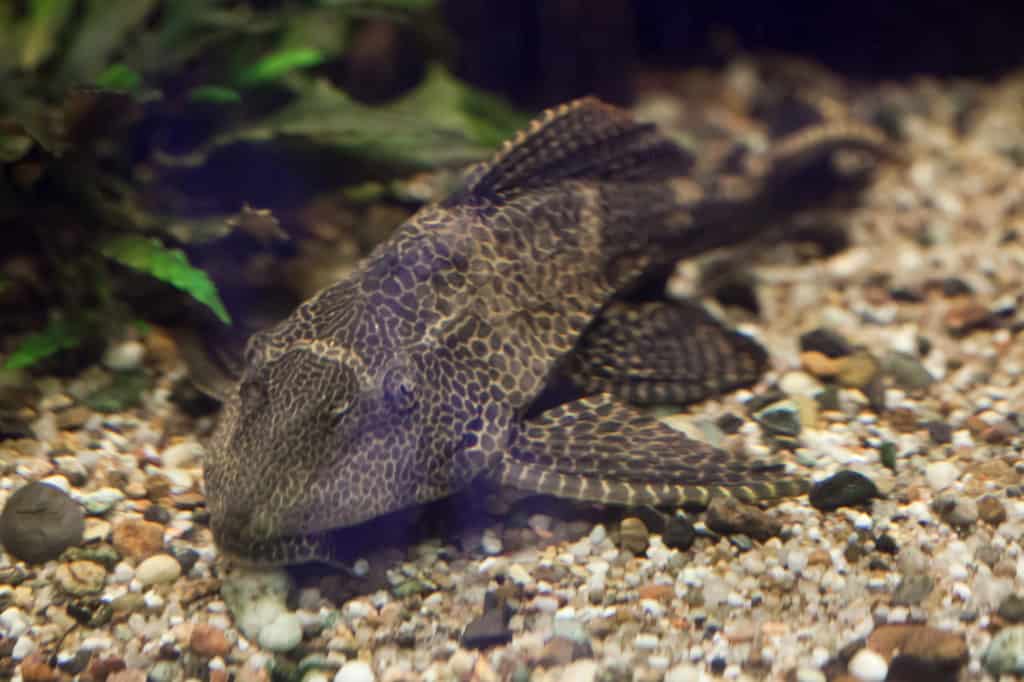
- Freshwater/Saltwater: Freshwater
- Tank size: 100 gallons
- Types of algae they eat: Brown algae, diatoms
You read that right – these fish need 100 gallons or more! Sailfin plecos can grow up to 20 inches in length, and need the space to realize their maximum lifespan and growth potential. The additional space prevents your fish from getting stressed out, and ensures that water quality is always the best it can be. If you intend to keep your sailfin plecos in a community tank, you will need to opt for something even larger.
Because sailfin plecos are so large, they’re also capable of covering a larger surface area. You can expect these big boys to eat a greater amount of algae than smaller fish, making them ideal for large tanks that require extra algal maintenance. However, you should also ensure that they’re getting enough to eat. If your tank doesn’t have enough algae, you can supplement their diet with algae wafers.
10. Rubber Lipped Pleco
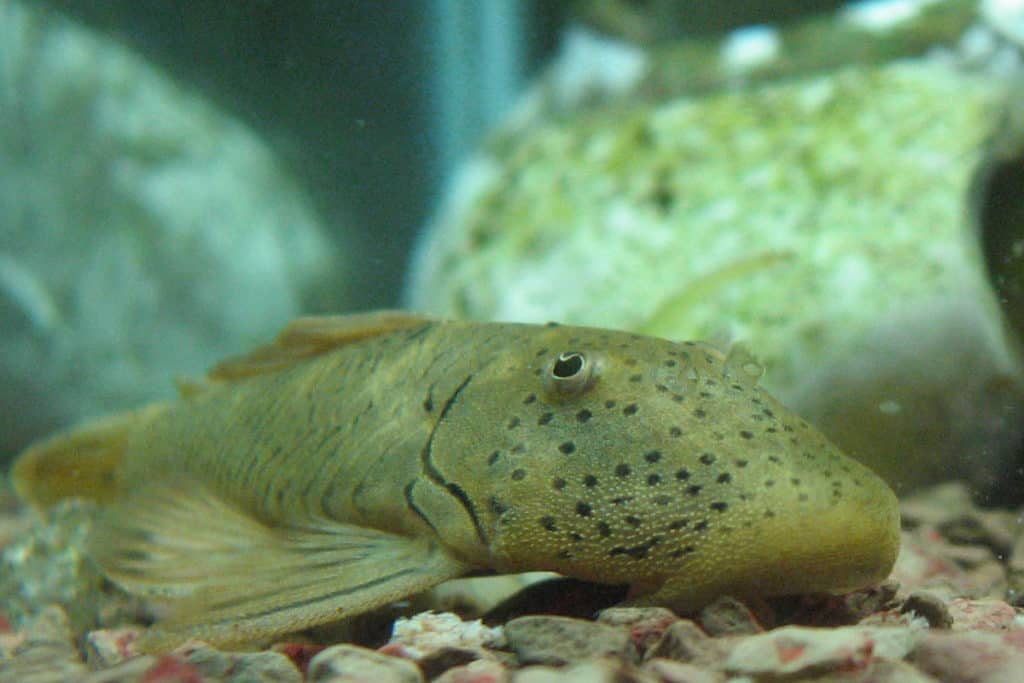
- Freshwater/Saltwater: Freshwater
- Tank size: 30 gallons
- Types of algae they eat: Plant algae, substrate algae, aquarium glass algae
If this fish’s name conjured up images of thick, voluptuous lips for you, know that you’re not too far off. The rubber lipped pleco sports a pair of suction-like lips that not only look unique but also serve an important purpose – eating algae.
The unique structure of their mouths allows them to cling onto any surface, so whether you’re talking about driftwood, the sides of your tank or rocks and gravel, this fish will make sure these surfaces stay clean.
11. American Flagfish
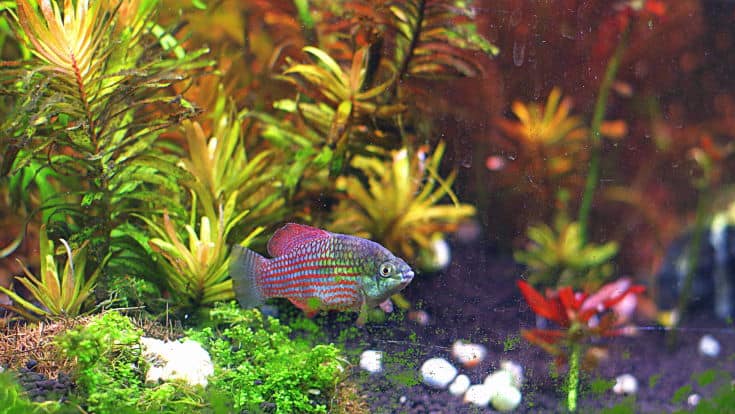
- Freshwater/Saltwater: Freshwater
- Tank size: 20 gallons
- Types of algae they eat: Brown, black beard algae, green thread algae, hair/string algae, and blanketweed algae
Personally speaking, I find the American flagfish to be one of the prettiest algae eaters that you can own. Though you may need to squint a little to see where the name of this fish comes from, the horizontal stripes make it pretty obvious why we have come to call this fish what its called.
This type of fish is an algae-eating machine, known for clearing black hair algae, string algae, soft algae, and even blanketweed algae. If you’ve not heard of the last one, just picture a tank full of seaweed, which is exactly what blanketweed algae looks like.
12. Nerite Snail
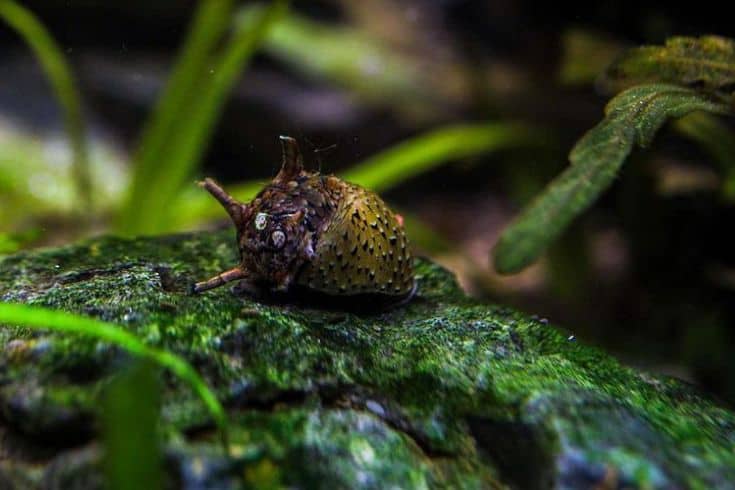
- Freshwater/Saltwater: Freshwater and Saltwater
- Tank size: 10 gallons
- Types of algae they eat: Soft film algae, soft green algae, soft brown algae, and brown diatoms
Remember the mollies we talked about earlier? Well, much like the common molly, Nerite snails are perfectly content in both freshwater and brackish water. In fact, these snails need brackish water to reproduce!
Nerite snails rely exclusively on algae to get the nutrients they need, so these little guys will work day and night to feed themselves, keeping your tank sparkling clean in the process. Just be sure to always have enough algae in your tank for them to munch on. Oftentimes, fishkeepers go overboard with removing algae and end up not providing enough for their snails.
13. Rabbit Snail
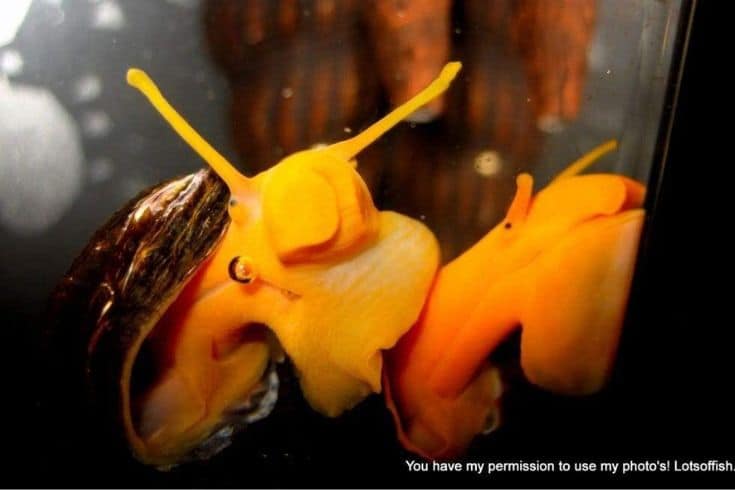
- Freshwater/Saltwater: Freshwater
- Tank size: 29 gallons
- Types of algae they eat: Plant algae, substrate algae, aquarium glass algae
Let’s move on to my favorite snail species – the rabbit snail! I love the stark contrast between its jet-black shell and bright orange body, so much so that I’m more than happy to give these guys the 30 gallons of space they need! Naturally, because they’re one of the largest freshwater snails out there, they will take center stage in any aquarium.
Not only do these snails look amazing, but they’ll also rid your aquarium glass, substrate, and plants of any algae. And yes, they’ll even clean your aquarium glass. Despite their large sizes, rabbit snails are surprisingly adept at clinging onto glass and tight spaces, giving them free rein to eat away at the pesky green stuff.
14. Ramshorn Snail

- Freshwater/Saltwater: Freshwater
- Tank size: 5 gallons
- Types of algae they eat: Soft green and brown algae
On the other end of the tank size spectrum, we have ramshorn snails. Most ramshorns grow to about half an inch in size, though you may encounter a couple of outliers that hit the 1-inch mark. Either way, these snails are perfectly sized for most tank sizes, with a minimum tank size requirement of just 5 gallons.
Because of their diminutive size, ramshorns are fairly limited in the types of algae they consume. They’ll only eat green and brown algae, leaving the more challenging varieties for the bigger snails. With that said, green and brown algae are the most common kinds in aquariums, so these guys might just do the trick!
15. Malaysian Trumpet Snail
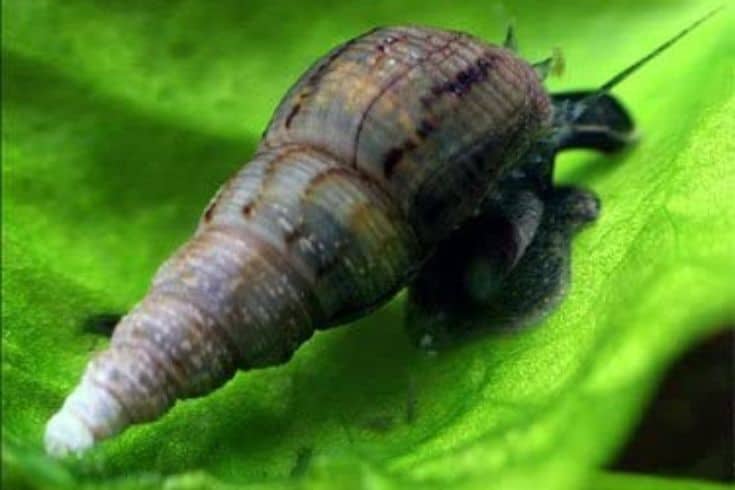
- Freshwater/Saltwater: Freshwater to salty brackish water
- Tank size: 3 gallons
- Types of algae they eat: Diatoms and soft algae
Much like the ramshorn snail, Malaysian trumpet snails are also capable of surviving in tiny tanks. As long as you have 3 gallons of water or more, you’ll be able to keep these algae eaters around. Just be sure to also provide some substrate. Though this may not make or break the Malaysian trumpet snail’s habitat, it does help them thrive.
Why is substate so important for these snails? Unlike other species, Malaysian trumpet snails burrow throughout their substrate so they can search out some tasty algae. They don’t usually crawl along surfaces like your glass or decorations, so you won’t typically find them cleaning such surfaces. Don’t worry though – their ability to burrow through substrate more than makes up for it.
16. Mystery Apple Snail
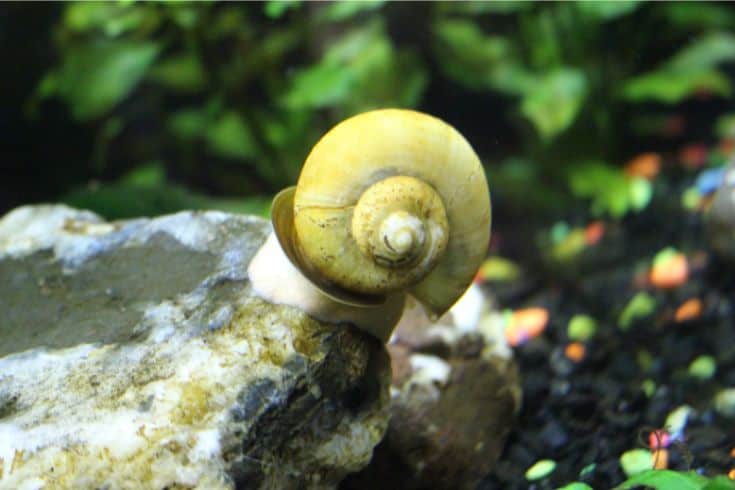
- Freshwater/Saltwater: Freshwater
- Tank size: 5 gallon
- Types of algae they eat: Plant algae, substrate algae, aquarium glass algae
The Mystery Apple snail relies on algae as its sole food source, making it arguably one of the most voracious algae eaters out there. These snails grow fairly large and will give your aquarium some much-needed color with its stunning combinations of yellow, brown, and cream.
Mystery Apple snails will clean glass, walls, rocks, and even decorations within your aquarium to rid you of any unwanted algae. And these guys don’t just stop there – they will boldly venture out and scavenge for bits of leftover food, leaving no trace behind!
17. Amano Shrimp
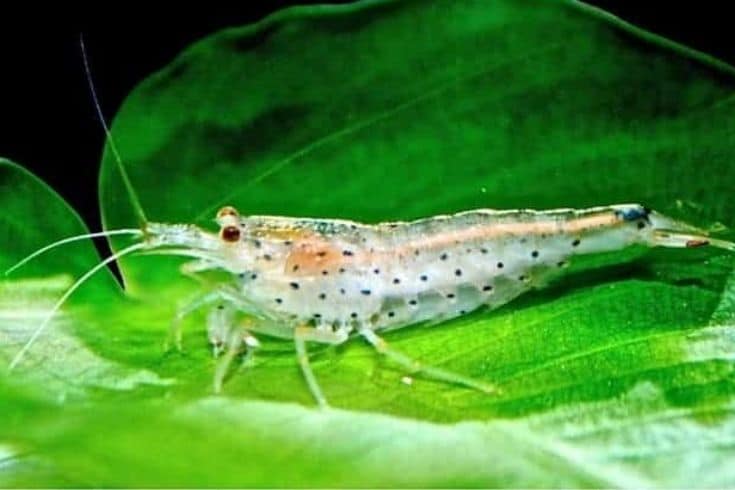
- Freshwater/Saltwater: Freshwater and saltwater (depending on their life stage)
- Tank size: 5 gallon
- Types of algae they eat: Hair algae, brush algae, black beard algae
As far as crustaceans go, Amano shrimp are some of the most effective algae eaters out there. These tiny little guys are so efficient at keeping tanks clean that they were named after aquascaping legend Takashi Amano, who used them extensively in his setups. And who could blame him? These guys will eat almost any type of algae, including black beard algae which can be really tough to take care of.
Because Amano shrimp hail from the Yamato rivers and swamps, they are rather accustomed to cool water. Therefore, you will need to keep your tank temperature around 60-72°F (15-22°C) to ensure their comfort. Make sure to choose tankmates that enjoy the same kind of environment, such as cherry shrimp, rasboras, and other small fish. However, Amano shrimp are also perfectly happy when kept alone.
18. Cardinal Sulawesi Shrimp
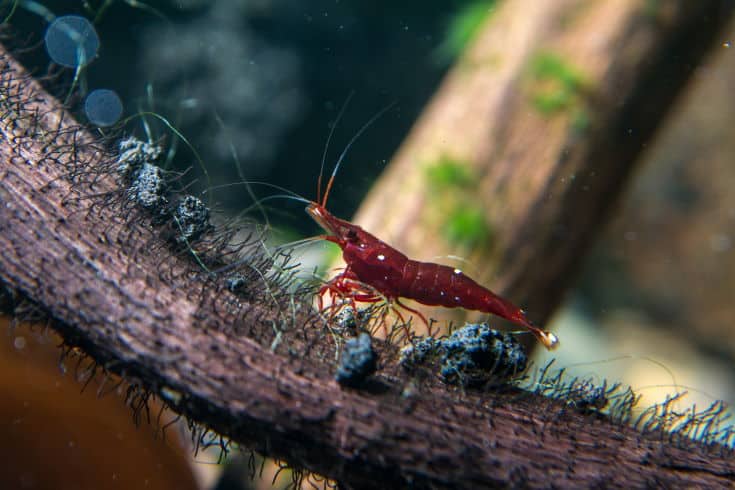
- Freshwater/Saltwater: Freshwater
- Tank size: 10 gallons
- Types of algae they eat: Biofilm, green algae, brown algae
The Amano shrimp may have a soft spot for cooler waters, but the Cardinal Sulawesi Shrimp? She’s a tropical gal. This comes as no surprise, seeing as they hail from the rivers of Sulawesi, Indonesia, where the climate is warm and humid year-round. To keep these shrimp happy, you’ll need to keep things between 78 to 88 ˚F (26 to 31 ˚C). You’ll almost certainly need a tank heater for these guys!
Once you’ve taken care of their temperature needs, you’ll be rewarded with an algae-eating machine! The Cardinal Sulawesi Shrimp is one of the best algae-eaters on the market, and they’ll happily chow down on biofilm, green algae, and brown algae. These are some of the most common algae types you’ll find in the average home aquarium, so the Cardinal Sulawesi Shrimp is an excellent choice for any tank.
19. Cherry Shrimp
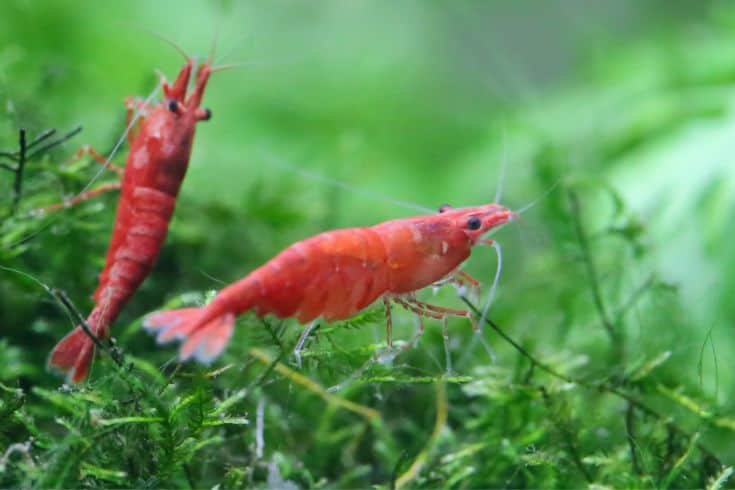
- Freshwater/Saltwater: Freshwater
- Tank size: 8 gallons
- Types of algae they eat: Soft green and brown algae
If you ask us, the cherry shrimp is one of the most underutilized species in algae control. Many people assume that this bright red creature is nothing more than just a pretty face. However, this could not be further from the truth.
Cherry shrimp are true scavengers that will eat green and brown algae while taking care of bits of leftover food. These shrimp are also small, making them perfect for you if you have a tinier tank!
20. Bamboo Shrimp
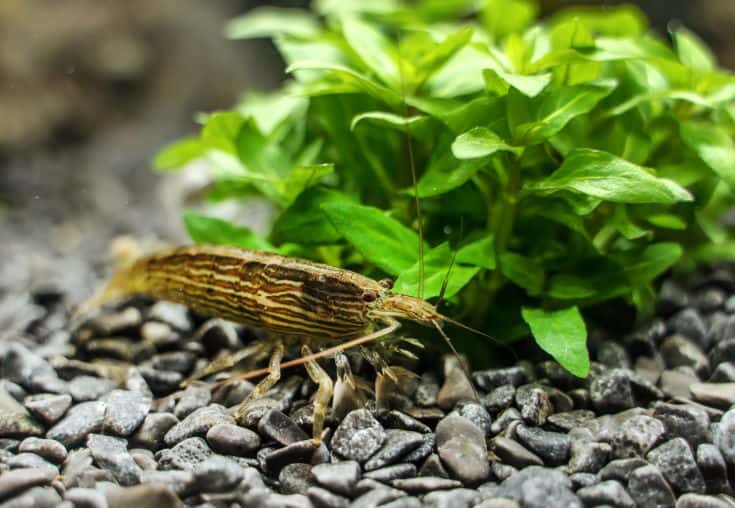
- Freshwater/Saltwater: Freshwater
- Tank size: 20 gallons
- Types of algae they eat: Microalgae
The bamboo shrimp is unique both in terms of its appearance as well as its diet. Looks-wise, the bamboo shrimp features an interesting body and several feather-like appendages. Diet-wise, this species relies primarily on microalgae drifting along the water column.
21. Ghost Shrimp
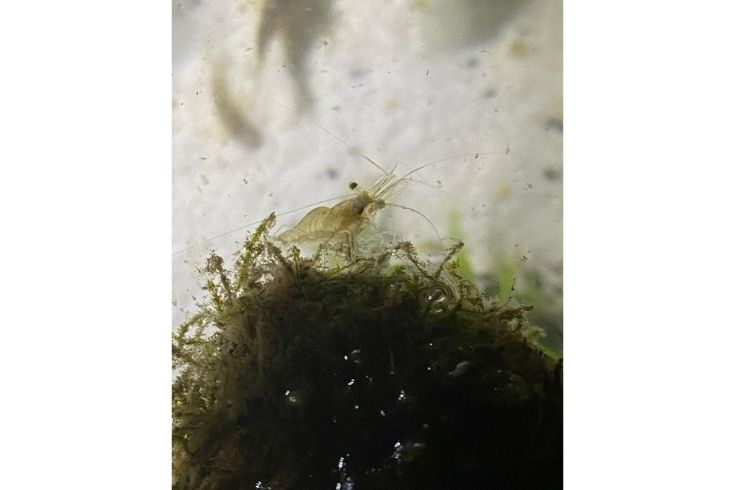
- Freshwater/Saltwater: Freshwater
- Tank size: 5 gallons
- Types of algae they eat: Diatoms and green algae
Last but not least, the ghost shrimp is a popular algae eater due to its rock-bottom price and hardiness. Although not as decorative as the bamboo variety, it’s still capable of keeping your tank clear from any green slime.
Final Thoughts
And there you have it! 21 of the best algae eaters available in the fishkeeping hobby. Whether you’re a first-time fish owner or an established hobbyist, there’s certainly something in this list that can be a great addition to your aquarium.
We hope you enjoyed this article! If you did, please share it with a friend or two. We appreciate your support! Thanks for reading, and good luck with your fish!
